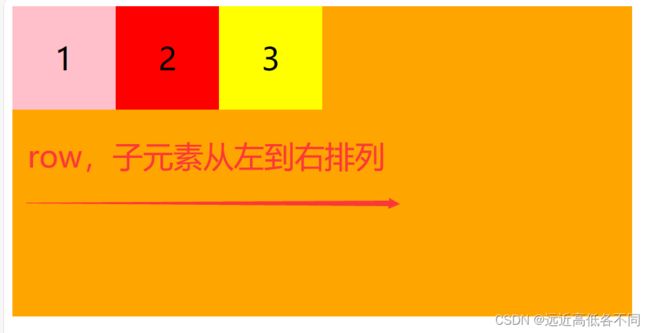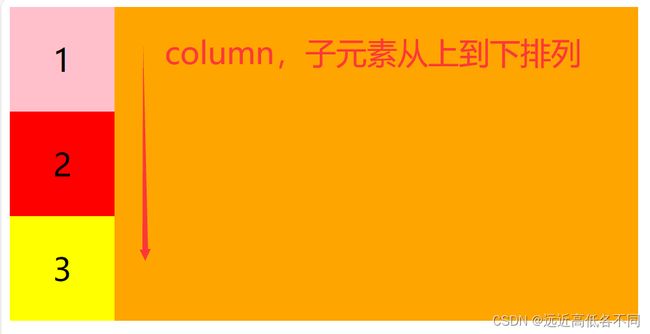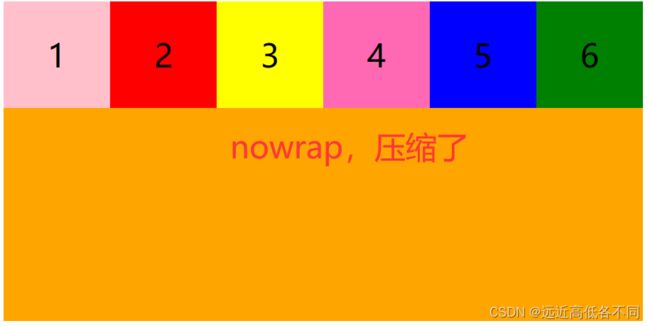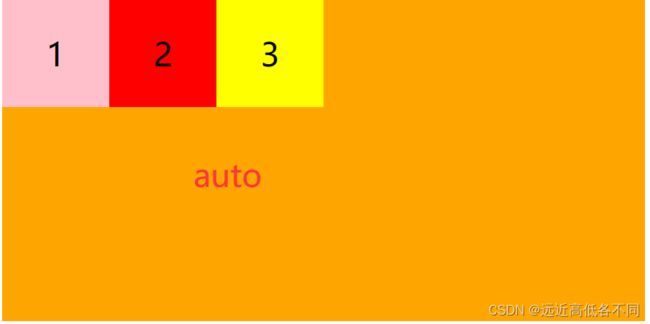CSS之弹性盒子Flexible Box
我想大家在做布局的时候,没接触flex布局之前,大家都是用浮动来布局的,但现在我们接触了flex布局之后,我只能说:“真香”。让我为大家介绍一下弹性盒子模型吧!
Flexible Box 弹性盒子
在我们使用弹性盒子时,我们需要给父级添加display:flex;
这是没给父级添加display:flex;时的样子:

这是给父级添加了display:flex;时的样子:

大家看,这是不是浮动该做的事情呀,我们flex也可以做,而且可以更简单更轻松的完成我们的布局,让我为大家介绍一下吧!
写在父级上常用的属性
一.父级添加:
1.display:flex(给父级添加)
不添加这个是开启不了flex布局的,flex的其他方法全部没有效果
.father {
/* 给父级宽高,开启弹性盒子布局 */
display: flex;
width: 600px;
height: 400px;
background-color: orange;
}
.father .son {
font-size: 20px;
width: 100px;
height: 100px;
}
2.flex-direction(给父级添加)
改变主轴方向
| 属性值 | 描述 |
|---|---|
| row | 默认值,主轴水平,子元素从左到右排列 |
| row-reverse | 主轴水平,子元素从右到左排列 |
| column | 主轴垂直,子元素从上到下排列 |
| column-reverse | 主轴垂直,子元素从下到上排列 |
flex-direction代码总结:
DOCTYPE html>
<html lang="en">
<head>
<meta charset="UTF-8">
<title>displaytitle>
<style>
.father {
/* 给父级宽高,开启弹性盒子布局 */
display: flex;
width: 600px;
height: 300px;
background-color: orange;
flex-direction: row; /* 默认值 */
/* flex-direction: row-reverse; */
/* flex-direction: column; */
/* flex-direction: column-reverse; */
}
.father .son {
text-align: center;
line-height: 100px;
font-size: 30px;
width: 100px;
height: 100px;
}
.father .son:nth-child(1){
background-color: pink;
}
.father .son:nth-child(2){
background-color: red;
}
.father .son:nth-child(3){
background-color: yellow;
}
style>
head>
<body>
<div class="father">
<div class="son">1div>
<div class="son">2div>
<div class="son">3div>
div>
body>
html>
3.justify-content(给父级添加)
设置主轴上子元素的对齐方式
| 属性值 | 描述 |
|---|---|
| flex-start | 默认值,所有子元素与主轴起始线对齐 |
| center | 所有子元素与主轴中心线对齐 |
| flex-end | 所有子元素与主轴终止线对齐 |
| space-around | 平均分配剩余空间但左右缝隙是中间的一半 |
| space-between | 先紧贴两边再平分剩余空间 |
| space-evenly | 平均分配空间 |
效果图:
flex-start:

center:

flex-end:

space-around:

space-between:
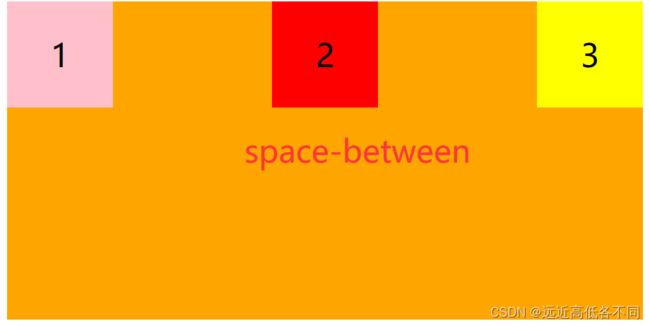
space-evenly:

flex-direction代码总结:
DOCTYPE html>
<html lang="en">
<head>
<meta charset="UTF-8">
<title>justify-contenttitle>
<style>
.father {
/* 给父级宽高,开启弹性盒子布局 */
display: flex;
width: 600px;
height: 300px;
background-color: orange;
justify-content: flex-start;
/* justify-content: center; */
/* justify-content: flex-end; */
/* justify-content: space-around; */
/* justify-content: space-between; */
/* justify-content: space-evenly; */
}
.father .son {
text-align: center;
line-height: 100px;
font-size: 30px;
width: 100px;
height: 100px;
}
.father .son:nth-child(1){
background-color: pink;
}
.father .son:nth-child(2){
background-color: red;
}
.father .son:nth-child(3){
background-color: yellow;
}
style>
head>
<body>
<div class="father">
<div class="son">1div>
<div class="son">2div>
<div class="son">3div>
div>
body>
html>
4.flex-wrap(给父级添加)
设置子元素是否换行
| 属性值 | 描述 |
|---|---|
| nowrap | 默认值,默认不换行,在一行显示 |
| wrap | 换行显示,第一行顶在上方 |
| wrap-reverse | 换行显示,第一行顶在下方 |
wrap:
DOCTYPE html>
<html lang="en">
<head>
<meta charset="UTF-8">
<title>flex-wraptitle>
<style>
.father {
/* 给父级宽高,开启弹性盒子布局 */
display: flex;
width: 600px;
height: 300px;
background-color: orange;
flex-wrap: nowrap;
/* flex-wrap: wrap; */
/* flex-wrap: wrap-reverse; */
}
.father .son {
text-align: center;
line-height: 100px;
font-size: 30px;
width: 150px;
height: 100px;
}
.father .son:nth-child(1){
background-color: pink;
}
.father .son:nth-child(2){
background-color: red;
}
.father .son:nth-child(3){
background-color: yellow;
}
.father .son:nth-child(4){
background-color: hotpink;
}
.father .son:nth-child(5){
background-color: blue;
}
.father .son:nth-child(6){
background-color: green;
}
style>
head>
<body>
<div class="father">
<div class="son">1div>
<div class="son">2div>
<div class="son">3div>
<div class="son">4div>
<div class="son">5div>
<div class="son">6div>
div>
body>
html>
5.align-items(给父级添加)
设置侧轴上的子元素排列方式(单行)
**特别注意:**这是单行的情况下
| 属性值 | 描述 |
|---|---|
| stretch | 默认值,如果子级没高度,各行将会伸展以占用剩余的空间 |
| flex-start | 所有子元素与侧轴起始线对齐 |
| flex-end | 所有子元素与侧轴中终止线对齐 |
| center | 所有子元素与侧轴中心线对齐 |
效果图:
stretch(当没给子级高度时):

flex-start:
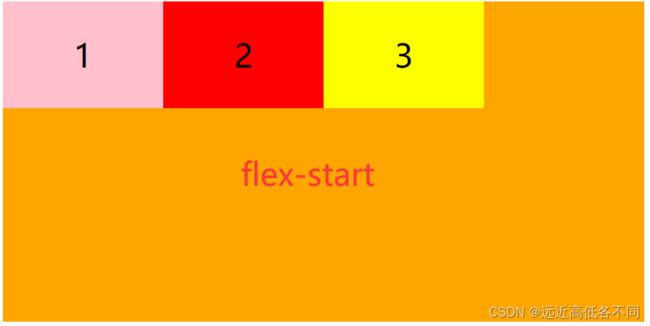
flex-end:
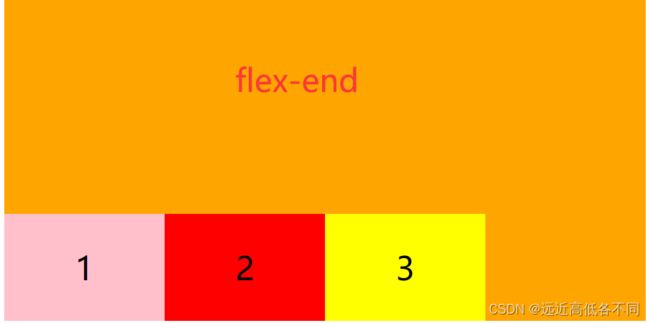
center:

align-items:
DOCTYPE html>
<html lang="en">
<head>
<meta charset="UTF-8">
<title>align-itemstitle>
<style>
.father {
/* 给父级宽高,开启弹性盒子布局 */
display: flex;
width: 600px;
height: 300px;
background-color: orange;
/* align-items: stretch; */
align-items: flex-start;
/* align-items: flex-end; */
/* align-items: center; */
}
.father .son {
text-align: center;
line-height: 100px;
font-size: 30px;
width: 150px;
height: 100px;
}
.father .son:nth-child(1){
background-color: pink;
}
.father .son:nth-child(2){
background-color: red;
}
.father .son:nth-child(3){
background-color: yellow;
}
style>
head>
<body>
<div class="father">
<div class="son">1div>
<div class="son">2div>
<div class="son">3div>
div>
body>
html>
6.align-content(给父级添加)
设置侧轴上子元素的排列方式(多行)
需要与flex-wrap一起使用
注意:多行的情况下,修改 flex-wrap 属性的行为,类似 align-items, 但不是设置子元素对齐,而是设置行对齐
| 属性值 | 描述 |
|---|---|
| stretch | 默认值,如果子级没高度,各行将会伸展以占用剩余的空间 |
| flex-start | 所有子元素与侧轴起始线对齐 |
| flex-end | 所有子元素与侧轴中终止线对齐 |
| center | 所有子元素与侧轴中心线对齐 |
| space-around | 平均分配剩余空间但上下缝隙是中间的一半 |
| space-between | 先紧贴两边再平分剩余空间 |
| space-evenly | 平均分配空间 |
效果图:
stretch:

flex-start:

flex-end:

center:
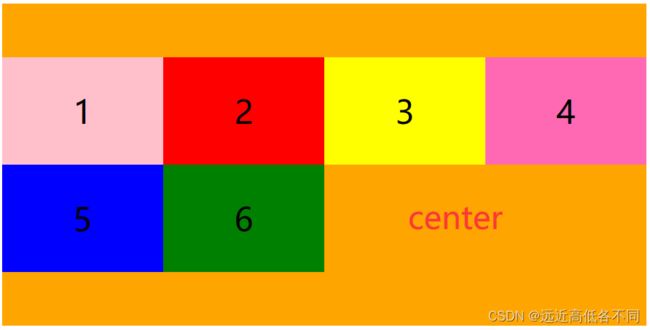
space-around:
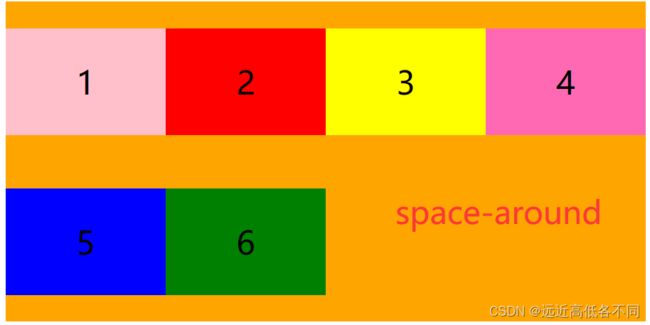
space-between:

space-evenly:

align-content:
DOCTYPE html>
<html lang="en">
<head>
<meta charset="UTF-8">
<title>align-contenttitle>
<style>
.father {
/* 给父级宽高,开启弹性盒子布局 */
display: flex;
width: 600px;
height: 300px;
background-color: orange;
flex-wrap: wrap;
/* align-content: stretch; */
align-content: flex-start;
/* align-content: flex-end; */
/* align-content: center; */
/* align-content: space-around; */
/* align-content: space-between; */
/* align-content: space-evenly; */
}
.father .son {
text-align: center;
line-height: 100px;
font-size: 30px;
width: 150px;
height: 100px;
}
.father .son:nth-child(1){
background-color: pink;
}
.father .son:nth-child(2){
background-color: red;
}
.father .son:nth-child(3){
background-color: yellow;
}
.father .son:nth-child(4){
background-color: hotpink;
}
.father .son:nth-child(5){
background-color: blue;
}
.father .son:nth-child(6){
background-color: green;
}
style>
head>
<body>
<div class="father">
<div class="son">1div>
<div class="son">2div>
<div class="son">3div>
<div class="son">4div>
<div class="son">5div>
<div class="son">6div>
div>
body>
html>
7.flex-flow(给父级添加)
复合属性,把设置主轴方向和是否换行(换列)简写
语法:flex-flow :主轴方向 是否换行;
主轴方向与是否换行请看2与4的介绍
二.子级添加
1.align-self
用于设置弹性元素自身在侧轴(纵轴)方向上的对齐方式。
注:给子元素设置
| 属性值 | 描述 |
|---|---|
| auto | 默认值,计算值为元素的父元素的’align-items’值,如果其没有父元素,则计算值为’stretch’。 |
| flex-start | 弹性盒子元素的侧轴(纵轴)起始位置的边界紧靠住该行的侧轴起始边界 |
| flex-end | 弹性盒子元素的侧轴(纵轴)起始位置的边界紧靠住该行的侧轴结束边界 |
| center | 弹性盒子元素在该行的侧轴(纵轴)上居中放置。(如果该行的尺寸小于弹性盒子元素的尺寸,则会向两个方向溢出相同的长度) |
| stretch | 在交叉轴方向上拉伸 |
| baseline | 如弹性盒子元素的行内轴与侧轴为同一条,则该值与’flex-start’等效。其它情况下,该值将参与基线对齐 |
align-self代码:
DOCTYPE html>
<html lang="en">
<head>
<meta charset="UTF-8">
<title>flex-selftitle>
<style>
.father {
/* 给父级宽高,开启弹性盒子布局 */
display: flex;
width: 600px;
height: 300px;
background-color: orange;
}
.father .son {
text-align: center;
line-height: 100px;
font-size: 30px;
width: 100px;
height: 100px;
}
.father .son:nth-child(1){
background-color: pink;
}
.father .son:nth-child(2){
background-color: red;
align-self: auto;
/* align-self: flex-start; */
/* align-self: flex-end; */
/* align-self: center; */
/* align-self: stretch; */
/* align-self: baseline; */
}
.father .son:nth-child(3){
background-color: yellow;
}
style>
head>
<body>
<div class="father">
<div class="son">1div>
<div class="son">2div>
<div class="son">3div>
div>
body>
html>
2.order(子级添加)
弹性子元素,排序,用整数值来定义排列顺序,数值小的排在最前面,可以 为负值,属性设置弹性容器内弹性子元素属性
DOCTYPE html>
<html lang="en">
<head>
<meta charset="UTF-8">
<title>ordertitle>
<style>
.father {
/* 给父级宽高,开启弹性盒子布局 */
display: flex;
width: 600px;
height: 300px;
background-color: orange;
}
.father .son {
text-align: center;
line-height: 100px;
font-size: 30px;
width: 100px;
height: 100px;
}
.father .son:nth-child(1){
background-color: pink;
order: 1;
}
.father .son:nth-child(2){
background-color: red;
order: 0;
}
.father .son:nth-child(3){
background-color: yellow;
order: -1;
}
style>
head>
<body>
<div class="father">
<div class="son">1div>
<div class="son">2div>
<div class="son">3div>
div>
body>
html>
3.flex-grow
用来分配剩余空间,需要主轴上有剩余空间
| 属性值 | 描述 |
|---|---|
| initial | 默认值与0一样 |
| 0 | 不放大也不缩小 |
| number | 正数 |
| flex-grow每一份都为1时: |

但第一个元素为1,第二个为2,第三个为3时:

flex-grow代码:
DOCTYPE html>
<html lang="en">
<head>
<meta charset="UTF-8">
<title>flex-growtitle>
<style>
.father {
/* 给父级宽高,开启弹性盒子布局 */
display: flex;
width: 600px;
height: 300px;
background-color: orange;
}
.father .son {
text-align: center;
line-height: 100px;
font-size: 30px;
width: 100px;
height: 100px;
}
.father .son:nth-child(1){
background-color: pink;
flex-grow: 1;
}
.father .son:nth-child(2){
background-color: red;
flex-grow: 2;
}
.father .son:nth-child(3){
background-color: yellow;
flex-grow: 3;
}
style>
head>
<body>
<div class="father">
<div class="son">1div>
<div class="son">2div>
<div class="son">3div>
div>
body>
html>
4.flex-base
会覆盖之前的width宽度,但该属性会被项目的min-width/min-height值覆盖
会自动计算主轴是否有多余空间
| 属性值 | 描述 |
|---|---|
| auto | 默认值,不发生改变 |
| % | 百分比 |
| 像素 | px |
我们给son1设置flex-base,如果3个元素的总宽度超出了父级,son1还会继续变宽吗?

会继续变宽,这是伸缩盒模型的缩,当我们宽度超出父级的时候,会缩回,让他们的宽度总和为600px

DOCTYPE html>
<html lang="en">
<head>
<meta charset="UTF-8">
<title>flex-basetitle>
<style>
.father {
/* 给父级宽高,开启弹性盒子布局 */
display: flex;
width: 600px;
height: 300px;
background-color: orange;
}
.father .son {
text-align: center;
line-height: 100px;
font-size: 30px;
width: 100px;
height: 100px;
}
.father .son:nth-child(1){
background-color: pink;
flex-basis: 800px;
}
.father .son:nth-child(2){
background-color: red;
}
.father .son:nth-child(3){
background-color: yellow;
}
style>
head>
<body>
<div class="father">
<div class="son">1div>
<div class="son">2div>
<div class="son">3div>
div>
body>
html>
6.flex-shrink
flex-shrink 主要处理当 flex 容器空间不足时候,单个元素的收缩比例,当超出父级宽度时,每个子元素原本宽度减去按比例分配的值,其剩余值为实际宽度
当前子元素宽度超出了主轴空间多少: 子元素的总宽度 - 父级的宽度 = 需要消化的宽度
子元素子元素的收缩因子之和: n
每一份就是: 需要消化的宽度/n = f
每一个项目: 子元素的宽度- shrink的份数 * f = 缩放的宽度
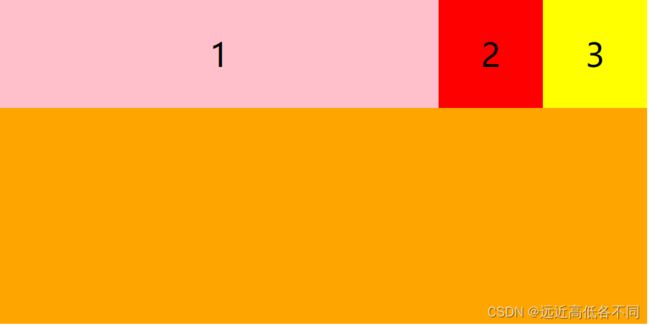
flex-shrink代码:
DOCTYPE html>
<html lang="en">
<head>
<meta charset="UTF-8">
<title>flex-basetitle>
<style>
.father {
/* 给父级宽高,开启弹性盒子布局 */
display: flex;
width: 600px;
height: 300px;
background-color: orange;
}
.father .son {
text-align: center;
line-height: 100px;
font-size: 30px;
width: 100px;
height: 100px;
}
.father .son:nth-child(1){
background-color: pink;
width: 420px;
flex-shrink: 1;
}
.father .son:nth-child(2){
background-color: red;
flex-shrink: 1;
}
.father .son:nth-child(3){
background-color: yellow;
flex-shrink: 1;
}
style>
head>
<body>
<div class="father">
<div class="son">1div>
<div class="son">2div>
<div class="son">3div>
div>
body>
html>
7.flex
项目缩放的简写,可以简写flex-grow flex-base flex-shrink
语法: flex: flex-grow flex-shrink flex-basis
推荐使用flex方法
常用:flex:1;对应flex: 1 1 auto

DOCTYPE html>
<html lang="en">
<head>
<meta charset="UTF-8">
<title>flextitle>
<style>
.father {
/* 给父级宽高,开启弹性盒子布局 */
display: flex;
width: 600px;
height: 300px;
background-color: orange;
}
.father .son {
text-align: center;
line-height: 100px;
font-size: 30px;
width: 100px;
height: 100px;
}
.father .son:nth-child(1){
background-color: pink;
flex: 1;
}
.father .son:nth-child(2){
background-color: red;
flex: 1;
}
.father .son:nth-child(3){
background-color: yellow;
flex: 1;
}
style>
head>
<body>
<div class="father">
<div class="son">1div>
<div class="son">2div>
<div class="son">3div>
div>
body>
html>
感谢大家阅读,如有不对的地方,可以向我提出,感谢大家!
